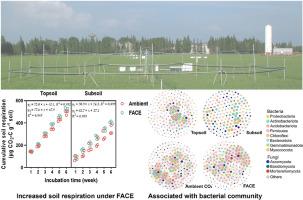Bacteria contribute more than fungi to SOC decomposition in a paddy field under long-term free-air CO2 enrichment
IF 3.3
2区 农林科学
Q1 ECOLOGY
引用次数: 0
Abstract
Microbial responses to future climate change are important in determining soil organic carbon cycling and evaluating carbon-climate feedback. Paddy soils from a 15-year free-air CO2 enrichment (FACE) experiment were incubated and analyzed to reveal the responses of soil microbial activity, community diversity and composition to the soil depth and elevated CO2. Network topology analysis was conducted to determine microbial complexity and stability, and Mantel tests were used to analyze the correlation between bacteria and fungi and soil respiration. Elevated CO2 stimulated cumulative soil respiration (topsoil 6.2 %, subsoil 21.8 %), which was positively correlated with bacterial diversity. The elevated CO2 effects on the microbial community were greater in the topsoil than in the subsoil, namely, bacterial diversity was increased by 2.1 % in the topsoil (0–15 cm). Elevated CO2 also increased the abundance of Nitrospirota in the top- but not in the subsoil. Fungal diversity and phyla were not affected by elevated CO2, but fungal diversity was significantly correlated with the contents of soil DOC, total dissolved N, and total P in the subsoil. Compared to the subsoil, bacterial richness was higher in topsoil, and more Ascomycota was found but fewer Mortierellomycota; the microbial network had a greater number of nodes and edges. These results suggested that 1) depth was a major factor affecting soil properties that determine microbial community and function; 2) bacterial taxa were more sensitive to elevated CO2 than fungal taxa; 3) elevated CO2 increased SOC decomposition directly via enhanced soil C availability and altered bacterial diversity and microbial complexity and stability.

在长期自由空气二氧化碳富集条件下,细菌比真菌对稻田中 SOC 分解的贡献更大
微生物对未来气候变化的反应对于确定土壤有机碳循环和评估碳-气候反馈非常重要。对一项为期 15 年的自由空气二氧化碳富集(FACE)实验中的稻田土壤进行了培养和分析,以揭示土壤微生物活动、群落多样性和组成对土壤深度和高浓度二氧化碳的响应。通过网络拓扑分析确定了微生物的复杂性和稳定性,并使用曼特尔检验分析了细菌和真菌与土壤呼吸作用之间的相关性。高浓度二氧化碳刺激了累积土壤呼吸作用(表土 6.2%,底土 21.8%),这与细菌多样性呈正相关。二氧化碳升高对表层土壤微生物群落的影响大于底层土壤,即表层土壤(0-15 厘米)的细菌多样性增加了 2.1%。二氧化碳浓度升高也增加了表层土壤中硝化螺菌的数量,但没有增加底层土壤中硝化螺菌的数量。真菌多样性和真菌门类不受二氧化碳升高的影响,但真菌多样性与底土中土壤 DOC、总溶解氮和总磷的含量显著相关。与底土相比,表层土壤的细菌丰富度更高,发现的子囊菌群更多,而毛霉菌群更少;微生物网络的节点和边缘数量更多。这些结果表明:1)深度是影响土壤特性的主要因素,而土壤特性决定了微生物群落和功能;2)细菌类群比真菌类群对升高的 CO2 更敏感;3)升高的 CO2 通过提高土壤 C 的可用性直接增加了 SOC 的分解,并改变了细菌多样性和微生物的复杂性和稳定性。
本文章由计算机程序翻译,如有差异,请以英文原文为准。
求助全文
约1分钟内获得全文
求助全文
来源期刊

European Journal of Soil Biology
环境科学-生态学
CiteScore
6.90
自引率
0.00%
发文量
51
审稿时长
27 days
期刊介绍:
The European Journal of Soil Biology covers all aspects of soil biology which deal with microbial and faunal ecology and activity in soils, as well as natural ecosystems or biomes connected to ecological interests: biodiversity, biological conservation, adaptation, impact of global changes on soil biodiversity and ecosystem functioning and effects and fate of pollutants as influenced by soil organisms. Different levels in ecosystem structure are taken into account: individuals, populations, communities and ecosystems themselves. At each level, different disciplinary approaches are welcomed: molecular biology, genetics, ecophysiology, ecology, biogeography and landscape ecology.
 求助内容:
求助内容: 应助结果提醒方式:
应助结果提醒方式:


